牛津译林版(2019)必修 第三册Unit 2 Natural disasters Welcome to the unit & Reading课件(共42张PPT)
文档属性
| 名称 | 牛津译林版(2019)必修 第三册Unit 2 Natural disasters Welcome to the unit & Reading课件(共42张PPT) | 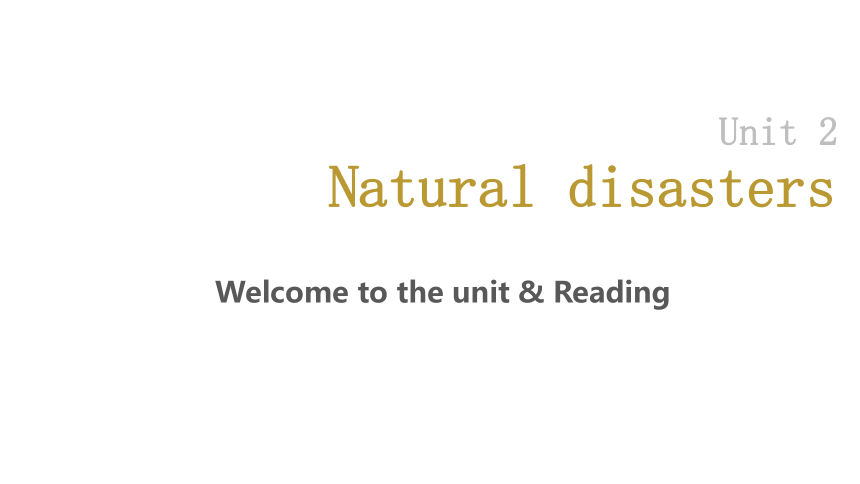 | |
| 格式 | pptx | ||
| 文件大小 | 19.7MB | ||
| 资源类型 | 教案 | ||
| 版本资源 | 牛津译林版(2019) | ||
| 科目 | 英语 | ||
| 更新时间 | 2024-04-02 10:38:01 | ||
图片预览

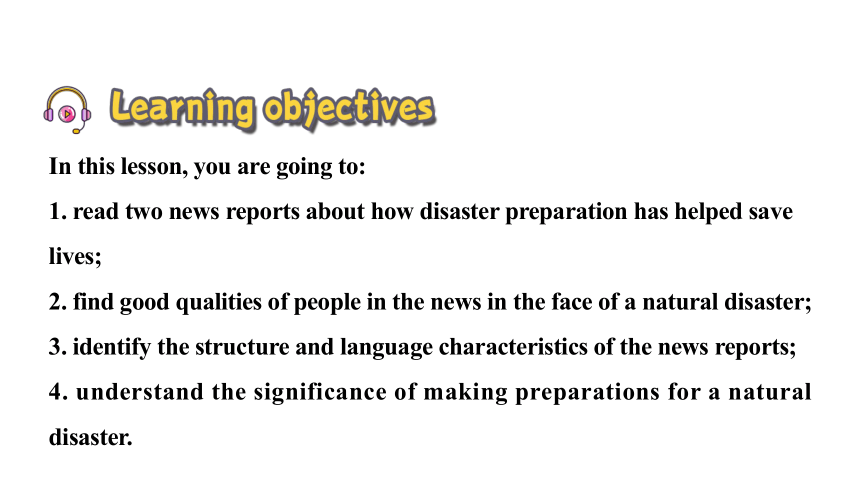
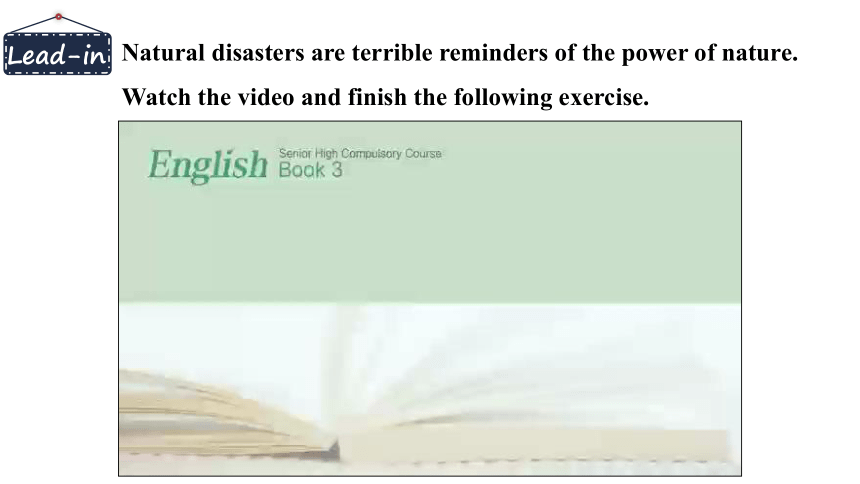
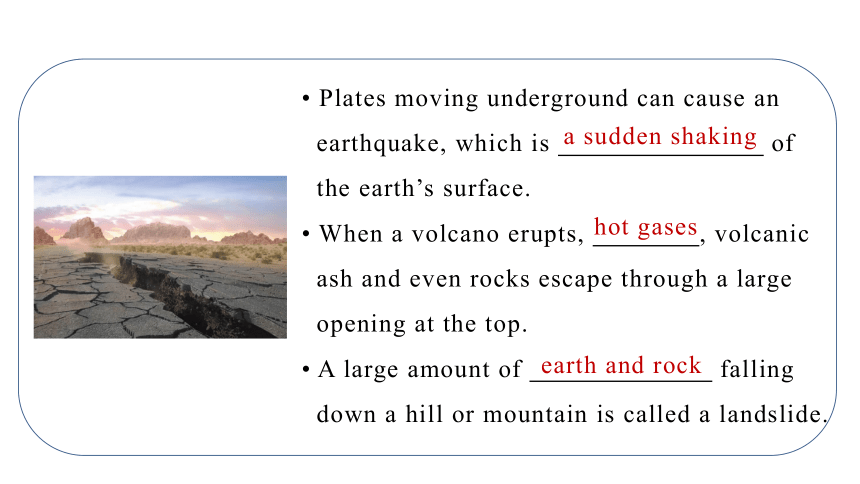
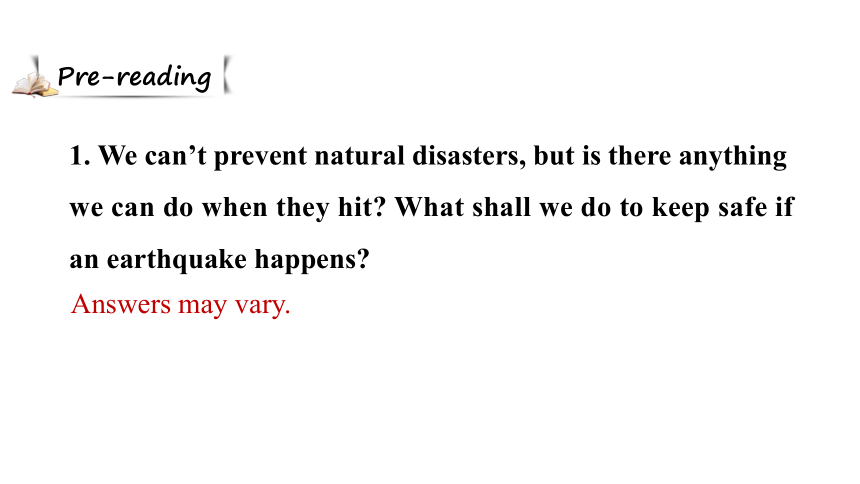
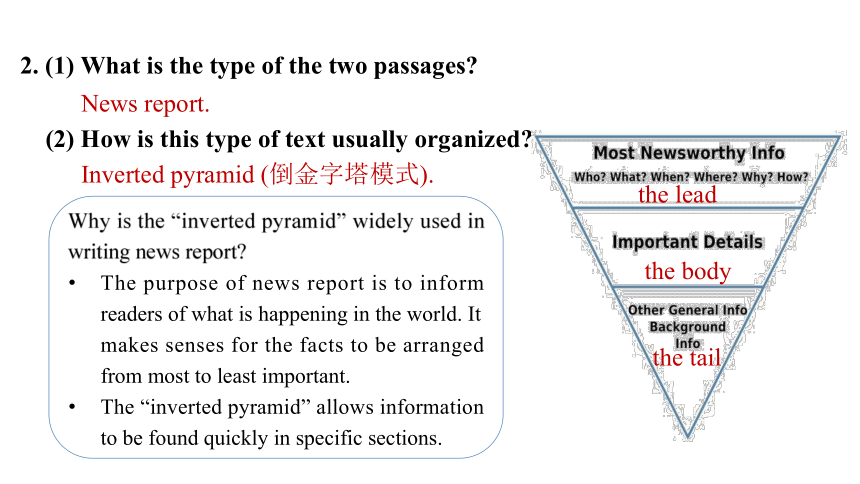
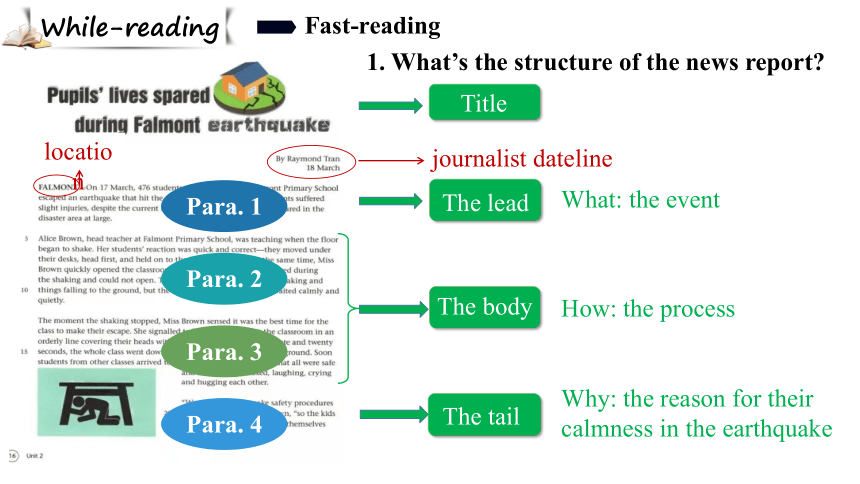
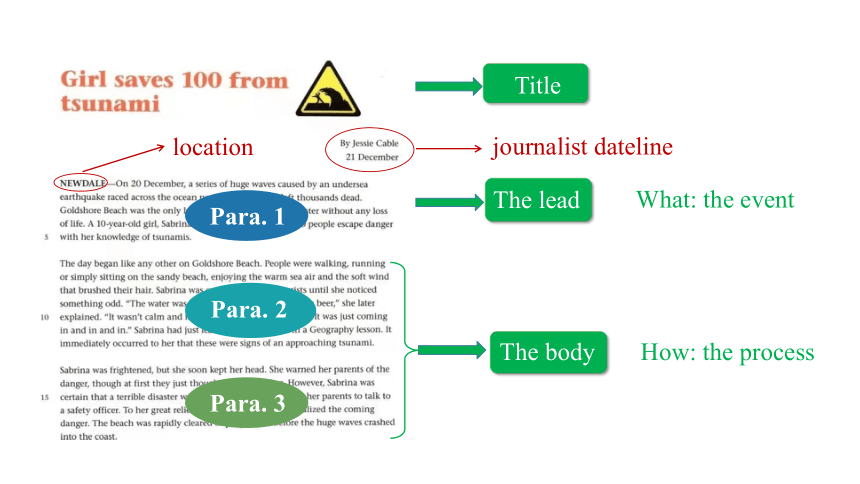
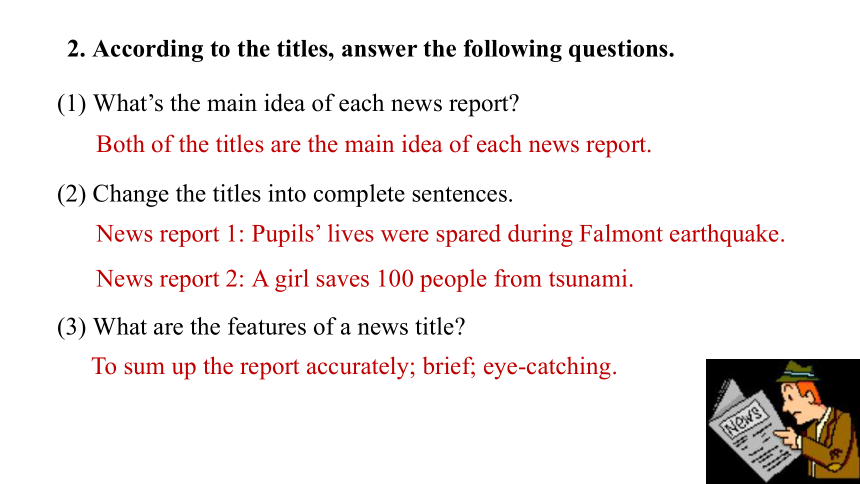
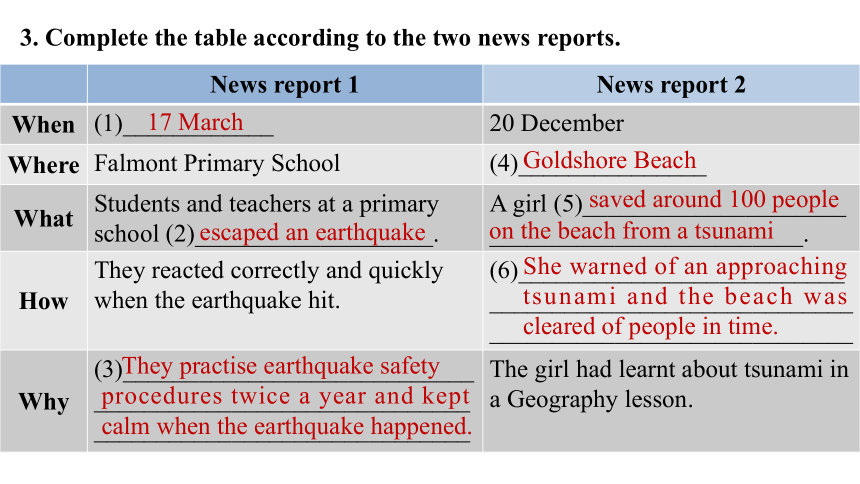
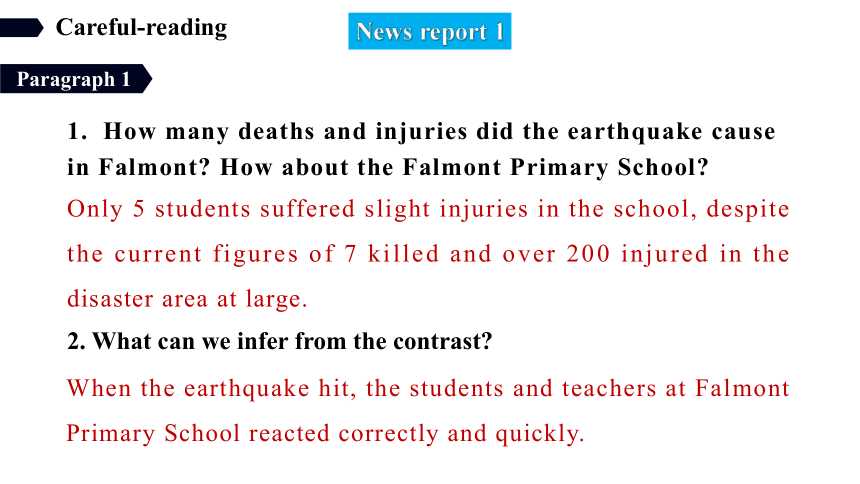
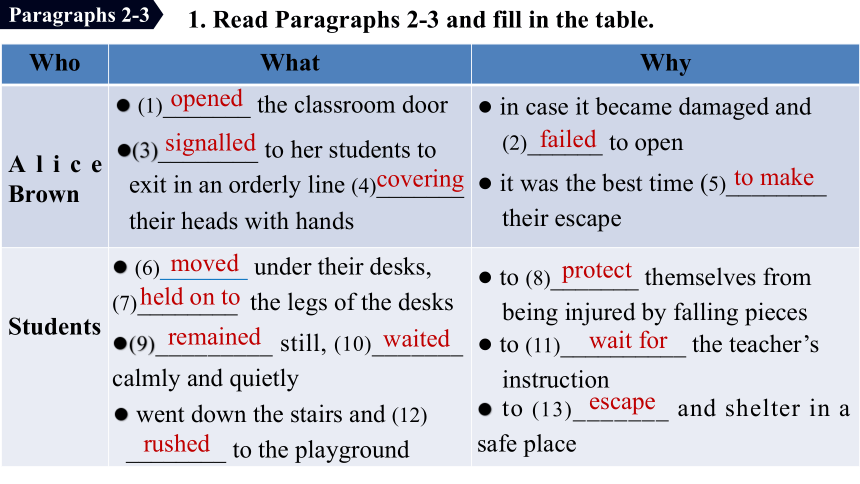
文档简介
(共42张PPT)
Unit 2
Natural disasters
Welcome to the unit & Reading
In this lesson, you are going to:
1. read two news reports about how disaster preparation has helped save
lives;
2. find good qualities of people in the news in the face of a natural disaster;
3. identify the structure and language characteristics of the news reports;
4. understand the significance of making preparations for a natural disaster.
Lead-in
Natural disasters are terrible reminders of the power of nature.
Watch the video and finish the following exercise.
Plates moving underground can cause an
earthquake, which is of
the earth’s surface.
When a volcano erupts, , volcanic
ash and even rocks escape through a large
opening at the top.
A large amount of falling
down a hill or mountain is called a landslide.
a sudden shaking
hot gases
earth and rock
1. We can’t prevent natural disasters, but is there anything we can do when they hit What shall we do to keep safe if an earthquake happens
Pre-reading
Answers may vary.
2. (1) What is the type of the two passages
News report.
(2) How is this type of text usually organized
Inverted pyramid (倒金字塔模式).
the lead
the body
the tail
Why is the “inverted pyramid” widely used in writing news report
The purpose of news report is to inform readers of what is happening in the world. It makes senses for the facts to be arranged from most to least important.
The “inverted pyramid” allows information to be found quickly in specific sections.
The lead
Title
The body
The tail
How: the process
Why: the reason for their
calmness in the earthquake
What: the event
Para. 1
Para. 2
Para. 3
Para. 4
journalist dateline
location
While-reading
1. What’s the structure of the news report
Fast-reading
The lead
Title
The body
How: the process
What: the event
journalist dateline
location
Para. 1
Para. 2
Para. 3
News report 1: Pupils’ lives were spared during Falmont earthquake.
News report 2: A girl saves 100 people from tsunami.
Both of the titles are the main idea of each news report.
(1) What’s the main idea of each news report
(2) Change the titles into complete sentences.
(3) What are the features of a news title
2. According to the titles, answer the following questions.
To sum up the report accurately; brief; eye-catching.
3. Complete the table according to the two news reports.
News report 1 News report 2
When (1)____________ 20 December
Where Falmont Primary School (4)_______________
What Students and teachers at a primary school (2)___________________. A girl (5)_____________________
_________________________.
How They reacted correctly and quickly when the earthquake hit. (6)____________________________________________________________________________________
Why (3)________________________________________________________________________________________ The girl had learnt about tsunami in a Geography lesson.
17 March
Goldshore Beach
escaped an earthquake
saved around 100 people
She warned of an approaching tsunami and the beach was cleared of people in time.
They practise earthquake safety
on the beach from a tsunami
procedures twice a year and kept calm when the earthquake happened.
News report 1
How many deaths and injuries did the earthquake cause
in Falmont How about the Falmont Primary School
Only 5 students suffered slight injuries in the school, despite the current figures of 7 killed and over 200 injured in the disaster area at large.
When the earthquake hit, the students and teachers at Falmont Primary School reacted correctly and quickly.
Careful-reading
Paragraph 1
2. What can we infer from the contrast
Who What Why
Alice Brown ● (1)_______ the classroom door
Students
●(3)________ to her students to
exit in an orderly line (4)_______
their heads with hands
● in case it became damaged and
(2)______ to open
● it was the best time (5)________
their escape
● (6)_______ under their desks,
(7)________ the legs of the desks
●(9)_________ still, (10)_______ calmly and quietly
● went down the stairs and (12)
________ to the playground
● to (8)_______ themselves from
being injured by falling pieces
● to (11)__________ the teacher’s
instruction
● to (13)_______ and shelter in a safe place
opened
signalled
covering
failed
moved
held on to
remained
waited
rushed
to make
protect
escape
wait for
1. Read Paragraphs 2-3 and fill in the table.
Paragraphs 2-3
2. Choose correct actions according to the article.
a. Practise earthquake safety procedures
b. Rush to the playground
c. Move under desk
d. Have a roll call
e. Open the door
For an earthquake Before
During
After
a
c, e
b, d
3. Which word can be used to replace the phrase “held on to” in Para. 2
A. Grasped. B. Carried.
C. Designed. D. Removed.
√
4. (1) What does “a roll call” in Para. 3 mean What did it confirm
A roll call means the reading of a list of names, which confirmed that all students were safe and sound.
(2) How did the students feel after the roll call
They relaxed, laughing, crying and hugging each other.
5. What can we infer from the second and third paragraphs
A. Alice Brown was too nervous to say one word.
B. Alice Brown was calm, organized and thoughtful.
C. Alice Brown was irresponsible.
D. Alice Brown was cold-hearted.
√
Miss Brown’s words showed that .
A. few students were always calm
B. Miss Brown was good at dealing with all kinds of problems
C. practising earthquake safety procedures was very important for students
D. earthquakes often happened in Falmont
√
Paragraph 4
Why was Goldshore Beach the only local beach to survive the disaster without any loss of life
It was Sabrina who saved people with her knowledge of tsunamis.
Paragraph 1
News report 2
1. What did Sabrina notice about the sea
A. The water was frothy(多泡的;起泡的) and kept coming in.
B. It was calm and going in and out.
C. The water was warm.
D. There was nothing special.
√
Paragraphs 2-3
At first, she was shocked but she soon calmed herself down.
2. What does the author mean by saying “..., but she soon kept her head”
3. What’s the right order according to the passage
a. Sabrina’s parents didn’t believe her words.
b. Sabrina’s parents talked to the safety officer.
c. The beach was rapidly cleared of people by the safety officer.
d. People were enjoying the warm sea air and the soft wind happily.
e. Sabrina noticed something unusual and told her parents.
A.c—d—e—b—a B.e—a—b—c—d
C.d—e—a—b—c D.c—b—a—e—d
√
happy
4. How did Sabrina’s emotions change during the whole event
frightened
calm
relieved
5. Which of the following words can best describe Sabrina
A. Enthusiastic and doubtful.
B. Kind and calm.
C. Sympathetic and generous.
D. Ambitious and tolerant.
√
Post-reading
Language characteristics of news reports
1. What is the feature of the two sentences
On 17 March, 476 students and 36 teachers at Falmont Primary School escaped an earthquake that hit the county at 2:27 p.m.
(News report 1)
A 10-year-old girl, Sabrina Andron, helped around 100 people escape danger… (News report 2)
Accurate. All the key factors such as who, what, when, where, how are included and accurately stated.
Her students’ reaction was quick and correct—they moved under their desks, head first, and held on to the legs of the desks.
(News report 1)
2. What is the feature of the sentence
Brief. Use the description of movement to tell readers the whole process.
3. What is the feature of the two sentences
“We practise earthquake safety procedures twice a year,” said Miss Brown, “so the kids were calm enough to protect themselves during the earthquake.” (News report 1)
“The water was like the bubbles on the top of a beer, ” she later explained. “It wasn’t calm and it wasn’t going in and then out. It was just coming in and in and in.” (News report 2)
Objective. Direct speech gives the exact words of a person and helps convince the reader that the report is real.
4. The news reports describe scenes using different senses. Find the sentences using senses and figure out the function of using different senses.
There were loud crashes of glass breaking and things falling to the ground, but the students remained still and waited calmly and quietly.
(News report 1)
People were walking, running or simply sitting on the sandy beach, enjoying the warm sea air and the soft wind that brushed their hair.
(News report 2)
sight & hearing
sight
touch
When describing a scene, use sensory information to put the reader in the action. Such descriptive details allow the reader to be transported into the scene.
To be _________.
To be _______.
To be ___________.
...
To describe scenes ___________________.
accurate
brief
objective
using different senses
5. Conclude the language characteristics of news reports.
1. What can you learn from these two news reports (Critical thinking)
We cannot prevent natural disasters but we can arm ourselves with knowledge. Loss of life can be limited through disaster preparation. We need to respond to these situations calmly and quickly.
Discussion
2. What can be done to prepare for a natural disaster (Creative thinking)
(1) Equip ourselves with knowledge about certain disaster.
(2) Learn some techniques to help us survive in the disaster.
(3) Practice safety procedures and learn to keep calm in face of disasters.
主题升华
To prepare for the disaster, to protect ourselves.
Equip yourself with knowledge.
Drill, drill, drill!
Be calm, and be brave.
On 17 March, 476 students and 36 teachers at Falmont Primary School escaped an earthquake hitting the county at 2:27 p.m. Only 5 students suffered slight injuries, despite the current figures of 7 killed and over 200 1._______(injure) in the disaster area at large. Alice Brown was teaching 2._____ the floor began to shake. Her students’ reaction was quick and correct. 3.____ moment the shaking stopped, Miss Brown signalled to her students to exit the classroom in an 4._______(order) line covering their heads with their hands.
injured
when
The
orderly
Summary
She said that they practised earthquake safety 5.__________(procedure) twice a year, so the kids were calm enough to protect themselves during the earthquake.
On 20 December, a series of huge waves caused by an undersea earthquake raced across the ocean near Goldshore and left thousands dead. Goldshore Beach was the only local beach 6._________(survive) the disaster without any loss of life. When people were enjoying the warm sea air and the soft wind, Sabrina
procedures
to survive
noticed something odd. It occurred 7.___ her that these were signs of an approaching tsunami and then she asked her parents to talk to a 8.______(safe) officer. The officer immediately realized the 9._______(come) danger. The beach was rapidly cleared of people, just before the huge waves 10._______(crash) into the coast.
coming
crashed
to
safety
Analyze the key points of the text
FALMONT—on 17 March, 476 students and 36 teachers at Falmont Primary School escaped an earthquake that hit the country at 2:27 p.m. Only 5 students suffered slight injuries, despite the current figures of 7 killed and over 200 injured in the disaster area at large.
过去分词作定语,分别修饰前面的数词7和200
Para. 1
Alice Brown, head teacher at Falmont Primary School, was teaching when the floor began to shake. Her students’ reaction was quick and correct—they moved under their desks, head first, and held on to the legs of the desks. At the same time, Miss Brown quickly opened the classroom door, in case it became damaged during the shaking and could not open. There were loud crashes of glass breaking and things falling to the ground, but the students remained still and waited calmly and quietly.
be doing… when...意为“正在……这时……”
引导目的状语从句,意为“以防,以免”
是Alice Brown的同位语
Para. 2
The moment the shaking stopped, Miss Brown sensed it was the best time for the class to make their escape. She signalled to her students to exit the classroom in an orderly line covering their heads with their hands. Within one minute and twenty seconds, the whole class went down the stairs and rushed to the playground. Soon students from other classes arrived too. After a roll call confirmed that all were safe and sound, they relaxed, laughing, crying and hugging each other.
the moment=the minute/second/instant
that引导宾语从句
现在分词短语作伴随状语
Para. 3
省略了that的宾语从句
Analyze the key points of the text
NEWDALE—On 20 December, a series of huge waves caused by an undersea earthquake raced across the ocean near Goldshore and left thousands dead. Goldshore Beach was the only local beach to survive the disaster without any loss of life. A 10-year-old girl, Sabrina Andron, helped around 100 people escape danger with her knowledge of tsunamis.
过去分词短语作后置定语
leave+宾语+宾语补足语
动词不定式作后置定语
Para. 1
The day began like any other on Goldshore Beach. People were walking, running, or simply sitting on the sandy beach, enjoying the warm sea air and the soft wind that brushed their hair. Sabrina was one of the happy tourists until she noticed something odd. “The water was like the bubbles on the top of a beer,” she later explained, “It wasn’t calm and it wasn’t going in and then out. It was just coming in and in and in.” Sabrina had just learnt about tsunamis in a Geography lesson. It immediately occurred to her that these were signs of an approaching tsunami.
现在分词短语作伴随状语
It occurred to sb. that ...“某人突然想到……”
Para. 2
it作形式主语
Sabrina was frightened, but she soon kept her head. She warned her parents of the danger, though at first they just thought she was joking. However, Sabrina was certain that a terrible disaster on its way and kept asking her parents to talk to a safety officer. To her great relief, the officer immediately realized the coming danger. The beach was rapidly cleared of people, just before the huge waves crashed into the coast.
to one’s relief 令某人宽慰的是……
海滩上的人迅速疏散一空。
Para. 3
Homework
Preview language points and recite the key
points of the text.
Unit 2
Natural disasters
Welcome to the unit & Reading
In this lesson, you are going to:
1. read two news reports about how disaster preparation has helped save
lives;
2. find good qualities of people in the news in the face of a natural disaster;
3. identify the structure and language characteristics of the news reports;
4. understand the significance of making preparations for a natural disaster.
Lead-in
Natural disasters are terrible reminders of the power of nature.
Watch the video and finish the following exercise.
Plates moving underground can cause an
earthquake, which is of
the earth’s surface.
When a volcano erupts, , volcanic
ash and even rocks escape through a large
opening at the top.
A large amount of falling
down a hill or mountain is called a landslide.
a sudden shaking
hot gases
earth and rock
1. We can’t prevent natural disasters, but is there anything we can do when they hit What shall we do to keep safe if an earthquake happens
Pre-reading
Answers may vary.
2. (1) What is the type of the two passages
News report.
(2) How is this type of text usually organized
Inverted pyramid (倒金字塔模式).
the lead
the body
the tail
Why is the “inverted pyramid” widely used in writing news report
The purpose of news report is to inform readers of what is happening in the world. It makes senses for the facts to be arranged from most to least important.
The “inverted pyramid” allows information to be found quickly in specific sections.
The lead
Title
The body
The tail
How: the process
Why: the reason for their
calmness in the earthquake
What: the event
Para. 1
Para. 2
Para. 3
Para. 4
journalist dateline
location
While-reading
1. What’s the structure of the news report
Fast-reading
The lead
Title
The body
How: the process
What: the event
journalist dateline
location
Para. 1
Para. 2
Para. 3
News report 1: Pupils’ lives were spared during Falmont earthquake.
News report 2: A girl saves 100 people from tsunami.
Both of the titles are the main idea of each news report.
(1) What’s the main idea of each news report
(2) Change the titles into complete sentences.
(3) What are the features of a news title
2. According to the titles, answer the following questions.
To sum up the report accurately; brief; eye-catching.
3. Complete the table according to the two news reports.
News report 1 News report 2
When (1)____________ 20 December
Where Falmont Primary School (4)_______________
What Students and teachers at a primary school (2)___________________. A girl (5)_____________________
_________________________.
How They reacted correctly and quickly when the earthquake hit. (6)____________________________________________________________________________________
Why (3)________________________________________________________________________________________ The girl had learnt about tsunami in a Geography lesson.
17 March
Goldshore Beach
escaped an earthquake
saved around 100 people
She warned of an approaching tsunami and the beach was cleared of people in time.
They practise earthquake safety
on the beach from a tsunami
procedures twice a year and kept calm when the earthquake happened.
News report 1
How many deaths and injuries did the earthquake cause
in Falmont How about the Falmont Primary School
Only 5 students suffered slight injuries in the school, despite the current figures of 7 killed and over 200 injured in the disaster area at large.
When the earthquake hit, the students and teachers at Falmont Primary School reacted correctly and quickly.
Careful-reading
Paragraph 1
2. What can we infer from the contrast
Who What Why
Alice Brown ● (1)_______ the classroom door
Students
●(3)________ to her students to
exit in an orderly line (4)_______
their heads with hands
● in case it became damaged and
(2)______ to open
● it was the best time (5)________
their escape
● (6)_______ under their desks,
(7)________ the legs of the desks
●(9)_________ still, (10)_______ calmly and quietly
● went down the stairs and (12)
________ to the playground
● to (8)_______ themselves from
being injured by falling pieces
● to (11)__________ the teacher’s
instruction
● to (13)_______ and shelter in a safe place
opened
signalled
covering
failed
moved
held on to
remained
waited
rushed
to make
protect
escape
wait for
1. Read Paragraphs 2-3 and fill in the table.
Paragraphs 2-3
2. Choose correct actions according to the article.
a. Practise earthquake safety procedures
b. Rush to the playground
c. Move under desk
d. Have a roll call
e. Open the door
For an earthquake Before
During
After
a
c, e
b, d
3. Which word can be used to replace the phrase “held on to” in Para. 2
A. Grasped. B. Carried.
C. Designed. D. Removed.
√
4. (1) What does “a roll call” in Para. 3 mean What did it confirm
A roll call means the reading of a list of names, which confirmed that all students were safe and sound.
(2) How did the students feel after the roll call
They relaxed, laughing, crying and hugging each other.
5. What can we infer from the second and third paragraphs
A. Alice Brown was too nervous to say one word.
B. Alice Brown was calm, organized and thoughtful.
C. Alice Brown was irresponsible.
D. Alice Brown was cold-hearted.
√
Miss Brown’s words showed that .
A. few students were always calm
B. Miss Brown was good at dealing with all kinds of problems
C. practising earthquake safety procedures was very important for students
D. earthquakes often happened in Falmont
√
Paragraph 4
Why was Goldshore Beach the only local beach to survive the disaster without any loss of life
It was Sabrina who saved people with her knowledge of tsunamis.
Paragraph 1
News report 2
1. What did Sabrina notice about the sea
A. The water was frothy(多泡的;起泡的) and kept coming in.
B. It was calm and going in and out.
C. The water was warm.
D. There was nothing special.
√
Paragraphs 2-3
At first, she was shocked but she soon calmed herself down.
2. What does the author mean by saying “..., but she soon kept her head”
3. What’s the right order according to the passage
a. Sabrina’s parents didn’t believe her words.
b. Sabrina’s parents talked to the safety officer.
c. The beach was rapidly cleared of people by the safety officer.
d. People were enjoying the warm sea air and the soft wind happily.
e. Sabrina noticed something unusual and told her parents.
A.c—d—e—b—a B.e—a—b—c—d
C.d—e—a—b—c D.c—b—a—e—d
√
happy
4. How did Sabrina’s emotions change during the whole event
frightened
calm
relieved
5. Which of the following words can best describe Sabrina
A. Enthusiastic and doubtful.
B. Kind and calm.
C. Sympathetic and generous.
D. Ambitious and tolerant.
√
Post-reading
Language characteristics of news reports
1. What is the feature of the two sentences
On 17 March, 476 students and 36 teachers at Falmont Primary School escaped an earthquake that hit the county at 2:27 p.m.
(News report 1)
A 10-year-old girl, Sabrina Andron, helped around 100 people escape danger… (News report 2)
Accurate. All the key factors such as who, what, when, where, how are included and accurately stated.
Her students’ reaction was quick and correct—they moved under their desks, head first, and held on to the legs of the desks.
(News report 1)
2. What is the feature of the sentence
Brief. Use the description of movement to tell readers the whole process.
3. What is the feature of the two sentences
“We practise earthquake safety procedures twice a year,” said Miss Brown, “so the kids were calm enough to protect themselves during the earthquake.” (News report 1)
“The water was like the bubbles on the top of a beer, ” she later explained. “It wasn’t calm and it wasn’t going in and then out. It was just coming in and in and in.” (News report 2)
Objective. Direct speech gives the exact words of a person and helps convince the reader that the report is real.
4. The news reports describe scenes using different senses. Find the sentences using senses and figure out the function of using different senses.
There were loud crashes of glass breaking and things falling to the ground, but the students remained still and waited calmly and quietly.
(News report 1)
People were walking, running or simply sitting on the sandy beach, enjoying the warm sea air and the soft wind that brushed their hair.
(News report 2)
sight & hearing
sight
touch
When describing a scene, use sensory information to put the reader in the action. Such descriptive details allow the reader to be transported into the scene.
To be _________.
To be _______.
To be ___________.
...
To describe scenes ___________________.
accurate
brief
objective
using different senses
5. Conclude the language characteristics of news reports.
1. What can you learn from these two news reports (Critical thinking)
We cannot prevent natural disasters but we can arm ourselves with knowledge. Loss of life can be limited through disaster preparation. We need to respond to these situations calmly and quickly.
Discussion
2. What can be done to prepare for a natural disaster (Creative thinking)
(1) Equip ourselves with knowledge about certain disaster.
(2) Learn some techniques to help us survive in the disaster.
(3) Practice safety procedures and learn to keep calm in face of disasters.
主题升华
To prepare for the disaster, to protect ourselves.
Equip yourself with knowledge.
Drill, drill, drill!
Be calm, and be brave.
On 17 March, 476 students and 36 teachers at Falmont Primary School escaped an earthquake hitting the county at 2:27 p.m. Only 5 students suffered slight injuries, despite the current figures of 7 killed and over 200 1._______(injure) in the disaster area at large. Alice Brown was teaching 2._____ the floor began to shake. Her students’ reaction was quick and correct. 3.____ moment the shaking stopped, Miss Brown signalled to her students to exit the classroom in an 4._______(order) line covering their heads with their hands.
injured
when
The
orderly
Summary
She said that they practised earthquake safety 5.__________(procedure) twice a year, so the kids were calm enough to protect themselves during the earthquake.
On 20 December, a series of huge waves caused by an undersea earthquake raced across the ocean near Goldshore and left thousands dead. Goldshore Beach was the only local beach 6._________(survive) the disaster without any loss of life. When people were enjoying the warm sea air and the soft wind, Sabrina
procedures
to survive
noticed something odd. It occurred 7.___ her that these were signs of an approaching tsunami and then she asked her parents to talk to a 8.______(safe) officer. The officer immediately realized the 9._______(come) danger. The beach was rapidly cleared of people, just before the huge waves 10._______(crash) into the coast.
coming
crashed
to
safety
Analyze the key points of the text
FALMONT—on 17 March, 476 students and 36 teachers at Falmont Primary School escaped an earthquake that hit the country at 2:27 p.m. Only 5 students suffered slight injuries, despite the current figures of 7 killed and over 200 injured in the disaster area at large.
过去分词作定语,分别修饰前面的数词7和200
Para. 1
Alice Brown, head teacher at Falmont Primary School, was teaching when the floor began to shake. Her students’ reaction was quick and correct—they moved under their desks, head first, and held on to the legs of the desks. At the same time, Miss Brown quickly opened the classroom door, in case it became damaged during the shaking and could not open. There were loud crashes of glass breaking and things falling to the ground, but the students remained still and waited calmly and quietly.
be doing… when...意为“正在……这时……”
引导目的状语从句,意为“以防,以免”
是Alice Brown的同位语
Para. 2
The moment the shaking stopped, Miss Brown sensed it was the best time for the class to make their escape. She signalled to her students to exit the classroom in an orderly line covering their heads with their hands. Within one minute and twenty seconds, the whole class went down the stairs and rushed to the playground. Soon students from other classes arrived too. After a roll call confirmed that all were safe and sound, they relaxed, laughing, crying and hugging each other.
the moment=the minute/second/instant
that引导宾语从句
现在分词短语作伴随状语
Para. 3
省略了that的宾语从句
Analyze the key points of the text
NEWDALE—On 20 December, a series of huge waves caused by an undersea earthquake raced across the ocean near Goldshore and left thousands dead. Goldshore Beach was the only local beach to survive the disaster without any loss of life. A 10-year-old girl, Sabrina Andron, helped around 100 people escape danger with her knowledge of tsunamis.
过去分词短语作后置定语
leave+宾语+宾语补足语
动词不定式作后置定语
Para. 1
The day began like any other on Goldshore Beach. People were walking, running, or simply sitting on the sandy beach, enjoying the warm sea air and the soft wind that brushed their hair. Sabrina was one of the happy tourists until she noticed something odd. “The water was like the bubbles on the top of a beer,” she later explained, “It wasn’t calm and it wasn’t going in and then out. It was just coming in and in and in.” Sabrina had just learnt about tsunamis in a Geography lesson. It immediately occurred to her that these were signs of an approaching tsunami.
现在分词短语作伴随状语
It occurred to sb. that ...“某人突然想到……”
Para. 2
it作形式主语
Sabrina was frightened, but she soon kept her head. She warned her parents of the danger, though at first they just thought she was joking. However, Sabrina was certain that a terrible disaster on its way and kept asking her parents to talk to a safety officer. To her great relief, the officer immediately realized the coming danger. The beach was rapidly cleared of people, just before the huge waves crashed into the coast.
to one’s relief 令某人宽慰的是……
海滩上的人迅速疏散一空。
Para. 3
Homework
Preview language points and recite the key
points of the text.
同课章节目录
- Unit 1 Nature in the balance
- Welcome to the unit
- Reading
- Grammar and usage
- Integrated skills
- Extended reading
- Project
- Unit 2 Natural disasters
- Welcome to the unit
- Reading
- Grammar and usage
- Integrated skills
- Extended reading
- Project
- Unit 3 The world online
- Welcome to the unit
- Reading
- Grammar and usage
- Integrated skills
- Extended reading
- Project
- Unit 4 Scientists who changed the world
- Welcome to the unit
- Reading
- Grammar and usage
- Integrated skills
- Extended reading
- Project
